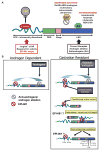Small molecule inhibitors targeting the "achilles' heel" of androgen receptor activity
- PMID: 21285252
- PMCID: PMC3132148
- DOI: 10.1158/0008-5472.CAN_10-3398
Small molecule inhibitors targeting the "achilles' heel" of androgen receptor activity
Abstract
Androgen ablation therapy remains the gold standard for the treatment of advanced prostate cancer, but unfortunately, it is not curative, and eventually the disease will return as lethal castration-resistant prostate cancer (CRPC). Mounting evidence supports the concept that development of CRPC is causally related to continued transactivation of androgen receptor (AR). All current therapies that target the AR are dependent on the presence of its C-terminal ligand-binding domain (LBD). However, it is the N-terminal domain (NTD) of the AR that is the "Achilles' heel" of AR activity, with AF-1 being essential for AR activity regardless of androgen. Recent efforts to develop drugs to the AR NTD have yielded EPI-001, a small molecule, sintokamide peptides, and decoys to the AR NTD with EPI-001, the best characterized and most promising for clinical development based upon specificity, low toxicity, and cytoreductive antitumor activity.
©2011 AACR.
Conflict of interest statement
Figures

References
-
- Sadar MD. Androgen-independent induction of prostate-specific antigen gene expression via cross-talk between the androgen receptor and protein kinase A signal transduction pathways. J Biol Chem. 1999;274:7777–83. - PubMed
-
- Moul JW, Srivastava S, McLeod DG. Molecular implications of the antiandrogen withdrawal syndrome. Semin Urol. 1995;13:157–163. - PubMed
-
- Visakorpi T, Hyytinen E, Koivisto P, et al. In vivo amplification of the androgen receptor gene and progression of human prostate cancer. Nat Genet. 1995;9:401–6. - PubMed
-
- Chen CD, Welsbie DS, Tran C, et al. Molecular determinants of resistance to antiandrogen therapy. Nat Med. 2004;10:33–9. - PubMed
-
- Bruchovsky N, Goldenberg SL, Mawji NR, Sadar MD. Evolving aspects of intermittent androgen blockage for prostate cancer: diagnosis and treatment of early tumor progression and maintenance of remission. Andrology in the 21st Century, Proceedings of the VIIth International Congress of Andrology; 2001. pp. 609–23.
Publication types
MeSH terms
Substances
Grants and funding
LinkOut - more resources
Full Text Sources
Other Literature Sources
Medical
Research Materials

